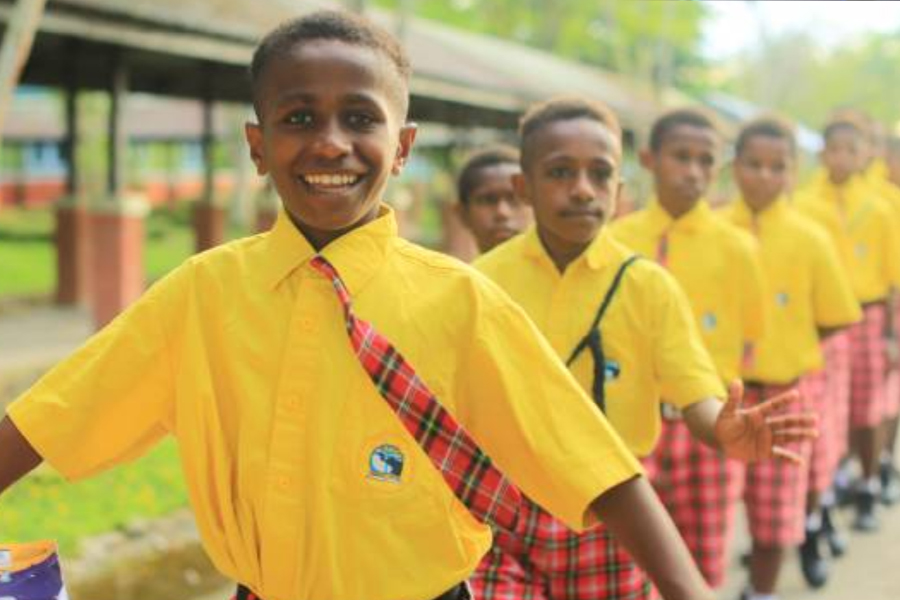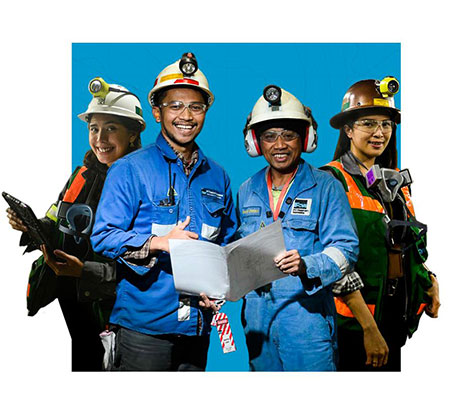16 December 2022

Mimika Regency located in Central Papua Province is not only a beneficiary of social investment by PT Freeport Indonesia (PTFI). Mimika Regency has the modern towns of Kuala Kencana and Tembagapura, a mining town holding wealth of copper and associated minerals silver and gold, making up one of the biggest deposits in the world. One of the foremost tribes inhabiting the region who have a unique art and culture is the Kamoro. The world-class copper mine operated by PT Freeport Indonesia has had a dynamic effect on the city of Timika, which is the economic hub of Mimika Regency.
Several international-standard infrastructure and facilities are to be found in Mimika. In addition to Mozes Kilangin International Airport built by Freeport, there is the five-star hotel Rimba Papua Hotel that at one point was under Sheraton management, and there is a golf course. Freeport also built the Mimika Sport Complex to support Papua’s hosting the 20th National Games PON last year. The stadium in this complex is by way of Freeport’s contributing to human resources development in the field of sports. The stadium is equipped with indoor courts for basketball, volleyball and badminton, as well as outdoor areas for athletics and football.
Towards developing prime talent in the field of sports in Papua, Freeport went on to establish Papua Football Academy, and Papua Athletics Center. Program participants undergo training regularly in Mimika Sport Complex (MSC). Currently, there are 30 Papua Football Academy trainees joined under the U-14 squad. They board in a dormitory located inside the MSC complex. The 30 youths are the first batch recruited during a scouting selection held in three cities, namely Mimika, Jayapura, and Merauke. There are plans to hold more selection events next year in Nabire, Serui, and Biak. The team will have an additional 30 members, bringing the total number of program participants to 60.
This team is expected to open the door for Papuan youths to become professional players. Papua Football Academy Head Trainer Wolfgang Pikal says team members train six times a week, from Monday through Saturday. Daily training takes 1.5 to 2 hours. The team members receive formal schooling while participating in the PFA program. The stadium is evidence of PT Freeport Indonesia contribution towards restoring Papua’s glory in the sports of football and athletics.
PTFI Contribution to Education
Sekolah Asrama Taruna Papua (SATP) is one of the biggest boarding schools to be found in Papua. With students hailing from the two major and five kindred tribes indigenous to the region, the school is one of the social investments PTFI is making, specifically for human resources development.
"The contribution of stakeholders, in particular PT Freeport Indonesia is outstanding. PT Freeport Indonesia does not only contribute funds, but also supports education through excellent programs such as the Alam Lestari program, which affords opportunities for our students to learn to love nature,” Deputy Chief Representative for Boarding School Development from the foundation Yayasan Pendidikan Lokon, Oktavanus Victor Rori asserted.
In developing education in Papua, the school’s vision is to become an institution of excellence in the field of education, through integration of several values. The values believed to positively affect and intensely affect the education process are truth, virtue and faith. The school’s primary mission is to bring education and wellbeing to children from the Amungme and Kamoro and five other kindred tribes inhabiting areas near the PT Freeport Indonesia operating site. As the education system applied is boarding school-based, the school provides appropriate facilities including healthy meals.
At the school, students are habituated to line up “one line hand back” to symbolize order and discipline. Sekolah Asrama Taruna Papua Principal Johana M.M Tnunay disclosed the curriculum applied in the school is grounded on Papua contextual life. Taruna Papua still applies the Merdeka Belajar (Freedom to Learn) curriculum that employs a revolutionary method. Students study not just in the classroom, but also undergo a learning process outside the classroom consisting of 60 percent presentation.
Extracurricular activities are also offered with 37 branches, under an excellence teach case program with instructors personally brought in from Oxford, as Papua’s second language is English. Towards shaping students with creative innovations, the school provides English language lessons beginning in the 3rd grade of primary school. IT lessons are also provided using personal computers at the primary school level and laptops at the middle school level. The Sekolah Asrama Taruna Papua boarding school is equipped with language labs, studios, science labs, and provides classes on protected wildlife.
Of no less importance, the Taruna Papua boarding school is highly supportive of developing skills and talents among its students, enabling them to build their personal potential towards attaining a brighter future. One honors student, Andrianus Beanal (Andre) with outstanding achievements in Taruna Papua, related his experience studying at SATP. Andre passed selection during a model audition and was dispatched to Jakarta where he placed third runner up thanks to support from the school.
In addition to its abundant mineral resources, Papua is rich in culture. There are more than 250 tribes in Papua with their own distinct language. One such mention-worthy tribe is the Kamoro in Mimika regency. The Kamoro Tribe own a culture and art forms that are highly unique, artistic and interesting. They have wood carvings, dances, woven items, customary rites, and songs that are presented during festivals and art and cultural expositions. One of the unique artforms in the Kamoro culture is their wood carvings depicting crocodiles and crab claws, which hold special significance.
They also have musical instruments made out of a single piece of wood with holes pierced with sharp seashells. They have shields made out of leather and colored with dyes made from the tomate and watae plants that resemble the rambutan. The foundation Yayasan Maramowe is an institution assisting the Kamoro to preserve their culture, and promote and market their artistic artifacts, in particular their wood carvings. The foundation collaborates with various entities to promote Kamoro art and culture to the public through exhibitions, sale of their products, and local educational programs.
Stories from the Mimika Lands
PT Freeport Indonesia’s mining operation area is located in the highland area, whereas the supporting facilities area is located in the lowland area. Waste from the minerals processing operation, or tailings are transported from the highland area through a riverine system that takes advantage of high rainfall, to be ultimately deposited in a dedicated deposition area in the lowlands named the Modified Ajkwa Deposition Area (ModADA).
The tailings deposited in the lowland area are utilized to increase land productivity and to create sustainable economic benefits. The tailings land is also used for farming, gardening, fishery, and biodiversity conservation purposes. At the Reclamation and Biodiversity Research Center, Roberth Sarwom who is the General Superintendent for Reclamation, Biodiversity & Education delivered a presentation on tailings. Tailings are the waste from PTFI production, consisting of fine particles that are the residue from an extraction process, and are safe for utilization.
As part of the company’s corporate responsibility, tailings are restored to their ecological function. To be of more benefit to the communities, a series of studies were conducted on utilizing the tailings land for productive purposes, among others through development of fishponds. Fish production from the ponds is yet to be marketed and is still undergoing development, with fish seed to be distributed among the communities.
Still another research conducted is for development of farming, through cultivation of agricultural crops and vegetable varieties. Vegetables planted in the reclamation center are harvested directly, with a diverse range of products yielded including long beans, eggplants, and chili peppers, to make sambal dishes. Tailings are rock that have their form altered to small particles. To fertilize the soil, compost must be used, produced from surrounding vegetation such as eceng gondok, a water hyacinth variety. This plant is collected and processed into compost for replanting. Soil containing tailings is nutrient-poor, and thus requires application of compost.
Despite its location in the tailings deposition area, air quality is good in the reclamation center area, as evident with the presence of a butterfly hatchery farm. The large number of butterflies indicates the presence of a clean environment and good air quality. Protected butterfly species such as the swallow-tail butterfly are among the butterfly species present in the hatchery.
Moving on to the highland area, reclamation activity is likewise conducted, primarily in the Grasberg area which ceased operating in 2020. To reach Grasberg, one must travel through the mining town of Tembagapura. From Tembagapura, the journey continues from a Tram Station to higher elevations. Tram 1 was built in 1971 as a means of transportation to the open pit area. This area is situated at an elevation of 2,847 meters above sea level. The Grasberg Mine area is shrouded by a heavy mist of indeterminate thickness.
The Grasberg open pit ended operation in 2019 and was immediately turned into a reclamation area. Reclamation in the Grasberg area consists of several stages in the process, the first being limestone capping, where the land is first prepped for reclaiming. The second stage is lime reject spreading, a further step involving levelling the land using heavy equipment. Once this is completed, the next step is revegetation. At an elevation of 4,250 meters above sea level, the plant ecosystem that is able to grow includes alpine and subalpine vegetations, such as a local grass species, Deschampsia klossii. The fourth stage is fertilizing. On sloping land, fertilizing is carried out by means of hydroseeding with a mixture of water and seeds sprayed onto the area intended for reclamation.
Finally, regular monitoring is conducted on the land. Grasberg Reclamation Area Supervisor Yanuarius Dumutu described, samples are taken from the area covering. Several plants that have grown for a certain length of time are monitored using equipment to check soil pH in its surroundings. The plant’s height is measured, and the presence of new plants is checked. Mimika Regency was a spectacular experience in observing the social investment made by PT Freeport Indonesia. It was evidence that responsible mining is not just beneficial, but also develops the impacted area.
Kami menghimbau para pencari kerja untuk berhati-hati dan mewaspadai beragam modus penipuan perekrutan yang mengatasnamakan PT Freeport Indonesia. Dalam setiap proses rekrutmen dan penerimaan karyawan, PT Freeport Indonesia maupun konsultan rekruitmennya tidak memungut biaya apapun.
Untuk melihat lowongan, silakan akses melalui link berikut: ptfi e-recruitment
Untuk melihat informasi magang, silakan akses melalui link berikut: Internship Program
